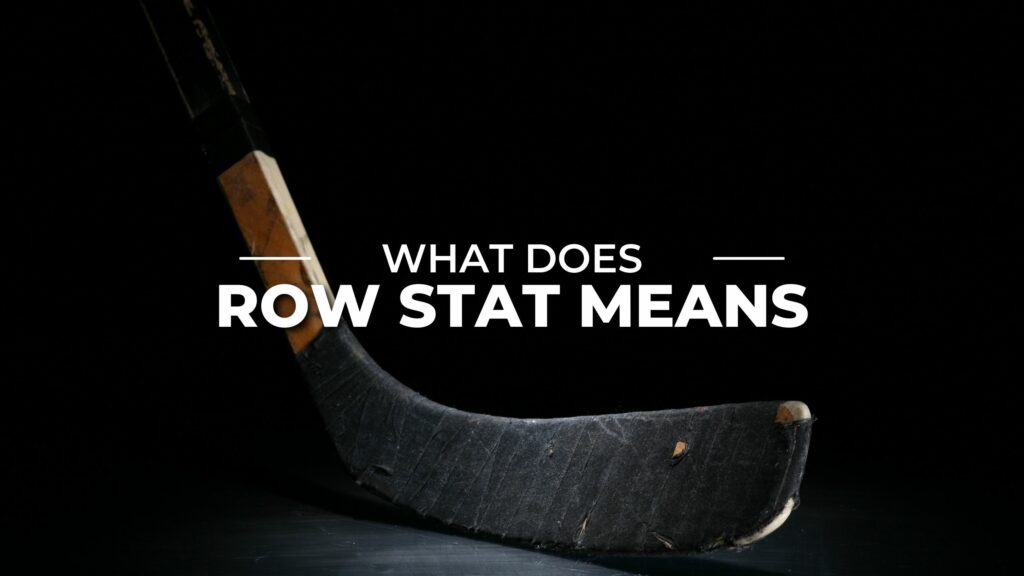What Is Row Stat in Hockey?
In the world of hockey, understanding the standings can sometimes feel like deciphering a complex code. With terms like points, wins, losses, and overtime losses, it’s easy to get lost in the sea of statistics. One such term that often leaves fans scratching their heads is “ROW.” So, what is ROW Stat in hockey standings?

What Is Row Stat In Hockey Standing?
ROW, which stands for Regulation plus Overtime Wins, is a tiebreaker used in the National Hockey League (NHL) standings. It is a way to determine a team’s position in the standings when teams have the same number of points.
In the NHL, teams earn two points for a win in regulation or overtime and one point for losing in overtime or a shootout. However, when two or more teams have the same number of points, ROW comes into play to break the tie.
ROW takes into account only the number of wins a team has accumulated in regulation time or overtime, excluding wins obtained in shootouts. This tiebreaker gives more weight to a team’s ability to win games outright, rather than relying on the shootout format.
The rationale behind using ROW as a tiebreaker is to reward teams that can win games within the allotted time frame, without the need for a shootout. It emphasizes the importance of a team’s performance during the regulation and overtime periods.
By using ROW as a tiebreaker, the NHL aims to encourage teams to play aggressively and go for the win in regulation or overtime, rather than playing defensively and relying on a shootout victory.
See also : How to make a disc golf basket
How Row Works?
To better understand how ROW works, let’s consider an example. Suppose two teams, Team A and Team B, have the same number of points in the standings. Team A has 40 wins, with 30 of those wins coming in regulation or overtime. Team B, on the other hand, has 40 wins, but only 25 of those wins came in regulation or overtime.
In this scenario, Team A would be ranked higher in the standings due to having a higher number of ROW. It indicates that Team A was able to secure victories within the allotted time more often than Team B.
ROW is an essential tiebreaker in hockey standings because it can have a significant impact on a team’s playoff positioning. In the NHL, tiebreakers are crucial when determining playoff berths, divisional rankings, and wild-card spots.
Understanding ROW can also enhance the viewing experience for fans, as it adds another layer of complexity to the standings. It allows fans to track the progress of their favorite teams and gain insights into their performance throughout the season.
What is Regulation and Overtime Wins
The Key to Success in SportsIn the world of sports, winning is everything. Whether it’s a thrilling game of basketball, an intense match of soccer, or a gripping hockey showdown, teams strive to come out on top. But what truly sets apart the great teams from the rest? It’s not just about the final score, but also the number of regulation and overtime wins.
Regulation Wins
Regulation wins refer to victories achieved within the standard allotted time for a game. In most sports, this includes four quarters, halves, or periods, depending on the specific rules. These wins showcase a team’s ability to outperform their opponents within the designated timeframe. It requires skill, strategy, and teamwork to secure a win before the clock runs out.
Overtime Wins
On the other hand, overtime wins occur when a game extends beyond the designated time due to a tied score at the end of regulation. Overtime periods offer an additional opportunity for teams to prove their mettle and secure a decisive victory. The pressure is heightened, and the stakes are even higher. Overtime wins often leave a lasting impression on both fans and opponents, highlighting a team’s resilience and ability to perform under pressure.
Why do regulation and overtime wins hold such significance?
One reason is that they demonstrate a team’s consistency and ability to perform well in different scenarios. Any team can have a lucky win here or there, but consistent success requires a deeper level of skill and determination. Teams that consistently secure regulation wins show that they have what it takes to dominate their opponents within the standard game time. Similarly, teams that excel in overtime situations display their ability to adapt, stay focused, and deliver when it matters most.
Moreover, regulation and overtime wins contribute to a team’s overall record and standings. In sports leagues where points and rankings determine playoff eligibility, these wins directly impact a team’s chances of advancing to the postseason. A higher number of regulation and overtime wins can be the deciding factor between securing a playoff spot or falling short.
Beyond the numbers, regulation and overtime wins also shape a team’s identity and reputation. These victories often become iconic moments in sports history, etching themselves into the memories of fans and players alike. They become part of a team’s narrative and contribute to its legacy. Whether it’s a buzzer-beating shot, a last-minute goal, or an extra-inning victory, these wins are remembered and celebrated for years to come.
Achieving regulation and overtime wins requires more than just talent. It demands dedication, hard work, and a never-give-up mentality. It requires players to push their limits, embrace pressure situations, and deliver when it matters most. Coaches play a crucial role in preparing their teams for both regulation and overtime scenarios, ensuring they have the skills and strategies to succeed in any situation.
How to get points in the NHL standings?
If you’re a fan of hockey, you probably know that the NHL standings are crucial for determining a team’s success in the league. But have you ever wondered how those points are earned? In this blog post, we will explore the different ways teams can accumulate points in the NHL standings.
The NHL standings are divided into two conferences, the Eastern Conference and the Western Conference, each consisting of two divisions. Within each division, teams compete against one another in regular season games, with the ultimate goal of earning as many points as possible.
how these points earned?
Let’s break it down
It’s worth noting that the NHL standings can change rapidly throughout the season, as teams play a varying number of games. This means that even a single win or loss can have a significant impact on a team’s position in the standings.
So, whether you’re a die-hard hockey fan or just starting to get into the game, understanding how points are earned in the NHL standings is essential. It adds an extra level of excitement to the game, as every goal and every win can have a lasting impact on a team’s journey towards the playoffs.
Wrapping Up
In conclusion, ROW, or Regulation plus Overtime Wins, is a tiebreaker used in hockey standings to determine a team’s position when teams have the same number of points. It focuses on the number of wins achieved in regulation time or overtime, excluding shootouts. By using ROW as a tiebreaker, the NHL encourages teams to play aggressively and go for the win within the allotted time. So, the next time you’re checking the standings and come across ROW, you’ll have a better understanding of its significance in the world of hockey.






